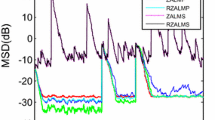Abstract
This paper presents an adaptive multiuser channel estimator using the reduced-Kalman least-mean-square (RK-LMS) algorithm. The frequency-selective fading channel is modeled as a tapped-delay-line filter with smoothly time-varying Rayleigh distributed tap coefficients. The multiuser channel estimator based on minimum-mean-square-error (MMSE) criterion is used to predict the filter coefficients. We also present its convergence characteristics and tracking performance using the RK-LMS algorithm. Unlike the previously available Kalman filtering algorithm based approach (Chen, Chen IEEE Trans Signal Process 49(7): 1523–1532, 2001) the incorporation of RK-LMS algorithm reduces the computational complexity of multiuser channel estimator used in the code division multiple access wireless systems. The computer simulation results are presented to demonstrate the substantial improvement in its tracking performance under the smoothly time-varying environment.
Similar content being viewed by others
References
Mulgrew B. (1987). Kalman filter technique in adaptive filtering. IEE Proceedings 134(3):239–243
McLaughlin S. (1991). Adaptive equalization via Kalman filtering techniques. IEE Proceedings 138(4):388–396
Chen L., Chen B. (2001). A robust adaptive DFE receiver for DS-CDMA system under multipath fading channels. IEEE Transactions on Signal Processing 49(7):1523–1532
Chen B., Tsai C., Hsu C. (2005). Robust adaptive MMSE/DFE multiuser detection in multipath fading channel with impulse noise. IEEE Transactions on Signal Processing 53(1):306–317
Davis L., Collings I., Evans R. (1998). Coupled estimators for equalization of fast-fading mobile channels. IEEE Transactions on Communications 46(10):1262–1265
Sayed A.H., Kailath T. (1994). A state-space approach to adaptive RLS filtering. IEEE Transactions on Signal Processing Magazine 11(3):18–60
Lindbom L., Sternad M., Ahlén A. (2001). Tracking of time-varying mobile radio channels—Part I: The Wiener LMS algorithm. IEEE Transactions on Commununications 49(12):2207–2217
Lindbom L., Sternad M., Ahlén A., Falkenström M. (2002). Tracking of time-varying mobile radio channels—Part II: A case study. IEEE Transactions on Communications 50(50):156–167
Gazor S. (1999). Predictions in LMS-Type adaptive algorithms for smoothly time-varying environments. IEEE Transactions on Signal Processings 47 (6):1735–1739
Widrow B., McCool J.M., Larimore M.G., Johnson C.R. (1976). Stationary and nonstationary learning characteristics of the LMS adaptive filter. IEEE Proceedings 64(8):1151–1162
Kohli A.K., Mehra D.K. (2006). Tracking of time-varying channels using two-step LMS-type adaptive algorithm. IEEE Transactions on Signal Processing 54(7): 2606–2615
Torlak M., Xu G. (1997). Blind multiuser channel estimation in asynchronous CDMA systems. IEEE Transactions on Signal Processing 45(1):137–147
Wang X., Poor H.V. (1998). Blind equalization and multiuser detection in dispersive CDMA channels. IEEE Transactions on Communications 46(1):91–103
Jakes W.C. (1994). Microwave mobile communications. New York, McGraw-Hill
Kalman R.E. (1960). A new approach to linear filtering and prediction problems. Transactions of the ASME, Series D, Journal of Basic Engineering 82:34–45
Kalman R.E. (1961). New results in linear filtering and prediction. Transactions of the ASME, Series D, Journal of Basic Engineering 83:95–108
Grewal M.S., Andrew A.P. (1993). Kalman filteing: Theory and practice. Englewood Cliffs, NJ: Prentice-Hall Inc
Kailath T. (1981). Lectures on Wiener and Kalman Filtering. NY, Springer-Verlag
Anderson B.D.O., Moore J.B. (1979). Optimal filtering. NJ, Prentice-Hall Inc
Kohli A.K., Mehra D.K. (2007). A two-stage MMSE multiuser decision feedback detector using successive/parallel interference cancellation. Digital Signal Processing 17(6):1007–1018
Author information
Authors and Affiliations
Corresponding author
Rights and permissions
About this article
Cite this article
Kohli, A.K., Mehra, D.K. Adaptive Multiuser Channel Estimation using Reduced Kalman/LMS Algorithm. Wireless Pers Commun 46, 507–521 (2008). https://doi.org/10.1007/s11277-008-9450-0
Received:
Accepted:
Published:
Issue Date:
DOI: https://doi.org/10.1007/s11277-008-9450-0




